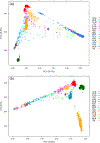Analysis of biogeographic ancestry reveals complex genetic histories for indigenous communities of St. Vincent and Trinidad
- PMID: 31125126
- PMCID: PMC8095721
- DOI: 10.1002/ajpa.23859
Analysis of biogeographic ancestry reveals complex genetic histories for indigenous communities of St. Vincent and Trinidad
Abstract
Objectives: From a genetic perspective, relatively little is known about how mass emigrations of African, European, and Asian peoples beginning in the 16th century affected Indigenous Caribbean populations. Therefore, we explored the impact of serial colonization on the genetic variation of the first Caribbean islanders.
Materials and methods: Sixty-four members of St. Vincent's Garifuna Community and 36 members of Trinidad's Santa Rosa First People's Community (FPC) of Arima were characterized for mitochondrial DNA and Y-chromosome diversity via direct sequencing and targeted SNP and STR genotyping. A subset of 32 Garifuna and 18 FPC participants were genotyped using the GenoChip 2.0 microarray. The resulting data were used to examine genetic diversity, admixture, and sex biased gene flow in the study communities.
Results: The Garifuna were most genetically comparable to African descendant populations, whereas the FPC were more similar to admixed American groups. Both communities also exhibited moderate frequencies of Indigenous American matrilines and patrilines. Autosomal SNP analysis indicated modest Indigenous American ancestry in these populations, while both showed varying degrees of African, European, South Asian, and East Asian ancestry, with patterns of sex-biased gene flow differing between the island communities.
Discussion: These patterns of genetic variation are consistent with historical records of migration, forced, or voluntary, and suggest that different migration events shaped the genetic make-up of each island community. This genomic study is the highest resolution analysis yet conducted with these communities, and provides a fuller understanding of the complex bio-histories of Indigenous Caribbean peoples in the Lesser Antilles.
Keywords: Caribbean; Y-chromosome; admixture; autosomal DNA; mtDNA.
© 2019 Wiley Periodicals, Inc.
Conflict of interest statement
CONFLICT OF INTEREST
The authors declare no potential conflict of interest.
Figures





References
-
- Allaire L (1980). On the historicity of Carib migrations in the Lesser Antilles. American Antiquity, 45, 238–245.
-
- Allaire L (2003). Agricultural societies in the Caribbean: The Lesser Antilles. In Sued-Badillo J (Ed.), General history of the Caribbean, vol 1. Autochthonous societies (p. 195, 227). London, England: Palgrave Macmillan.
-
- Athey TW (2006). Haplogroup prediction from Y-STR values using a Bayesian-allele-frequency approach. Journal of Genetic Genealogy, 2, 34–39.
Publication types
MeSH terms
Substances
Grants and funding
LinkOut - more resources
Full Text Sources

